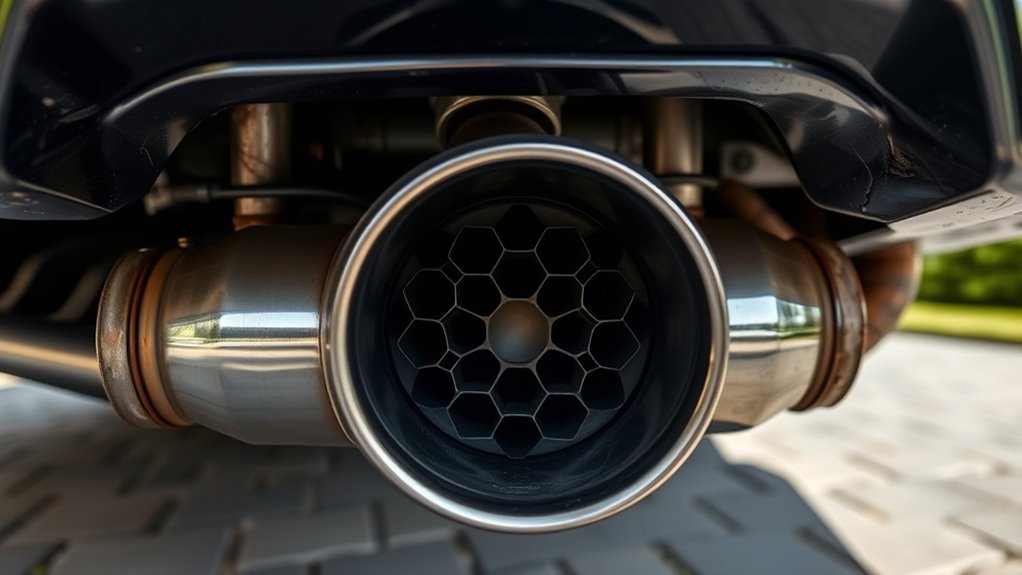The catalytic converter in your car reduces harmful emissions by transforming pollutants like carbon monoxide, nitrogen oxides, and hydrocarbons into safer substances before they reach the environment. It also helps maintain smooth exhaust flow, boosting engine performance, fuel efficiency, and responsiveness. A healthy converter guarantees your vehicle runs reliably and meets emissions standards. If you want to understand how to keep it functioning properly and avoid costly repairs, there’s more to discover below.
Key Takeaways
- The catalytic converter reduces harmful emissions by converting pollutants like carbon monoxide, nitrogen oxides, and hydrocarbons into safer substances.
- It ensures your vehicle complies with environmental regulations and minimizes its ecological footprint.
- The converter maintains smooth exhaust flow, supporting engine efficiency, performance, and better fuel economy.
- A failing catalytic converter can cause reduced engine power, increased fuel consumption, and check engine light activation.
- Proper maintenance prolongs converter life, prevents engine damage, and helps your vehicle operate reliably and environmentally friendly.

A catalytic converter plays a essential role in your car’s exhaust system by reducing harmful emissions before they reach the environment. When your engine runs, it produces pollutants like carbon monoxide, nitrogen oxides, and unburned hydrocarbons. The catalytic converter acts as a critical filter, transforming these dangerous gases into less harmful substances such as carbon dioxide, nitrogen, and water vapor. This process not only helps keep the air cleaner but also guarantees your vehicle complies with environmental regulations. As a result, the emissions reduction provided by the catalytic converter is indispensable in minimizing your car’s ecological footprint and promoting cleaner air for everyone.
Beyond environmental benefits, the catalytic converter also influences your engine’s performance. A properly functioning converter maintains a smooth exhaust flow, which can help your engine run more efficiently. When the converter is clogged or damaged, exhaust gases can back up, causing your engine to work harder and potentially decrease fuel economy. Conversely, a functioning catalytic converter ensures the best exhaust flow, allowing your engine to breathe freely. This balance enhances overall engine performance and can lead to improved acceleration, better throttle response, and more consistent operation.
You might not notice it daily, but the health of your catalytic converter directly impacts your driving experience. If it’s working well, your engine runs cleaner and more efficiently, with fewer emissions escaping into the environment. However, if it’s compromised—due to contamination, age, or damage—you might experience symptoms like reduced power, increased fuel consumption, or a check engine light. Addressing these issues promptly can help restore both emissions reduction and engine performance, preventing costly repairs down the line.
Maintaining your catalytic converter is straightforward but essential. Regular vehicle checkups, using the right fuel, and addressing engine issues early can prolong its lifespan. A healthy converter not only guarantees compliance with emissions standards but also keeps your engine operating at peak performance. Remember, neglecting it can lead to poor fuel economy, increased emissions, and potential damage to other engine components. By understanding its importance and keeping it in good condition, you guarantee your car runs efficiently, environmentally friendly, and reliably for miles to come. Proper maintenance of emission control devices is vital for ensuring long-term vehicle health and compliance.
Frequently Asked Questions
How Long Does a Catalytic Converter Typically Last?
Your catalytic converter typically lasts between 70,000 and 100,000 miles. To maximize its lifespan, follow maintenance tips like regular oil changes, using quality fuel, and addressing engine issues promptly. Keep an eye on warning lights or unusual exhaust smells, as these can signal problems. Proper care guarantees your catalytic converter stays efficient longer, saving you money on repairs and keeping your car environmentally friendly.
Can a Catalytic Converter Be Repaired or Only Replaced?
You can often repair a catalytic converter if the damage is minor, such as replacing the internal components or fixing leaks. However, for severe issues, replacement is usually necessary. Repair options are generally less expensive than full replacement, but consider cost considerations carefully, as repairs might only be temporary. Evaluate the extent of damage and consult a mechanic to decide whether repair or replacement offers the best long-term solution.
What Are Signs of a Failing Catalytic Converter?
Like a dimming light, a failing catalytic converter shows signs you can’t ignore. You might notice sensor failure alerts on your dashboard or experience unusual odors, often resembling rotten eggs. Your engine may also run poorly, with reduced fuel efficiency or strange noises. These symptoms indicate it’s time to have your converter checked, as ignoring them could lead to more costly repairs and emissions issues down the line.
Does Aftermarket Catalytic Converter Affect Vehicle Emissions?
An aftermarket catalytic converter can affect your vehicle’s emissions depending on its compatibility with your car and adherence to emission standards. If you choose an aftermarket part that meets or exceeds your vehicle’s emissions requirements, it shouldn’t negatively impact emissions. However, incompatible or lower-quality converters might not effectively reduce pollutants, causing your vehicle to fail emissions tests or produce higher emissions. Always verify compatibility and compliance with local emission standards before installation.
Are Catalytic Converters Theft-Prone and How Can I Prevent Theft?
Yes, catalytic converters are theft-prone because they contain valuable metals like platinum, palladium, and rhodium. To prevent converter theft, you can install a protective shield, etch your vehicle identification number onto the converter, or park in well-lit, secure areas. Additionally, consider alarm systems or catalytic converter locks, which make theft more difficult and less attractive to thieves, giving you peace of mind.
Conclusion
Think of your catalytic converter as the heart of your car’s emissions system, tirelessly working behind the scenes to keep the air clean. Without it, your vehicle would be like a fire-breathing dragon, spewing smoke instead of breath. By ensuring it functions properly, you’re not just protecting your engine, but also helping the planet breathe easier. So, give your converter the love it deserves—because a healthy car starts with a healthy Earth.









